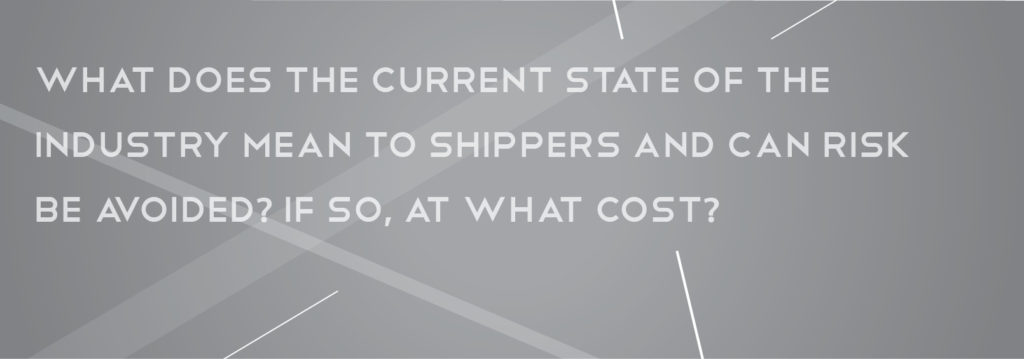The aftermath of the Hanjin bankruptcy hasn’t been pretty. The financial state of that company is reflective of the challenges many ocean lines are grappling with today. In the face of financial uncertainty, fear is something easily ignited and rumors only fan the flames. Look no further than the rumors that surrounded “K”Line a couple months ago to get a clearer picture.
What does the current state of the industry mean to shippers and can risk be avoided? If so, at what cost?
Let’s all take a deep breath and put things in perspective.
Everyone is trying to stay afloat
Most carriers are losing money and taking measures to mitigate those losses. The Drewry Container Forecaster has reported that ship line sales have decreased by $50 billion in the last two years. With talk that the industry has fallen below its depth during the global economic crisis in 2009, everyone is feeling the strain. By changing carriers, shippers run the risk of jumping from the frying pan into the fire. Many shippers did just that by believing Hyundai was on the ropes and partnering with Hanjin, only to have it file for bankruptcy in the end.
The room where it happens
The state of the ocean liner companies is unpredictable up to the bitter end. With many seats at the table (high-level management, banks, and government officials) what’s given as public knowledge and what’s really happening behind closed doors can be very different. Take “K”Line for example. Rumors swirled that it was going to meet the same fate as Hanjin, be bought by Maersk or merge with another Japanese carrier. A union between Japanese lines being the least feasible in the public eye, a merger between carriers NYK Line, “K”Line and MOL was just announced! This just shows that nobody really knows what’s going to happen until it hits the headlines. The level of uncertainty and guessing involved makes any effort at intelligent diversification and loss mitigation challenging at best.
VSAs abound
Just because you contract with a “financially sound” carrier doesn’t isolate you from the risk inherent in today’s shipping industry. Vessel Sharing Agreements (VSAs) have become standard practice and are present in virtually every trade lane maintained. VSAs are reached between ocean lines that agree to cooperate on a specified trade lane. These agreements are often cost effective for container shipping companies by allowing them to share space and increase container capacity. While VSAs reduce strain on a shipping line, the customer may find out their cargo is on a vessel they didn’t actually contract with. This whole idea is a bit unsettling, but nearly impossible to avoid, unless you simply don’t ship anything by ocean. Even the largest two ocean lines (Maersk and MSC) vessel share on the vast majority of trade lanes. Furthermore, by avoiding “financially risky” ocean lines, you may be jeopardizing your own cargo in the long run, experiencing an increase in cost and transit time. You may even end up of the very same ocean lines you were trying to avoid via VSAs!
So if functioning under an atmosphere of uncertainty is the reality for many shipping companies, what can be done to ensure your cargo is safe and secure?
One thought is to diversify cargo among many carriers thereby reducing financial risk. The old saying “don’t carry all your eggs in one basket” can be applied here. It should be noted though, that the “spread my carriers out” strategy isn’t one size fits all. That solution may work for shipping behemoths like Walmart, but for a company shipping 5 containers per week, that’s just not realistic. Companies that do not have the shipment volume necessary to diversify without negatively affecting cost may be better served with an alternative.
Instead of diversifying, concentrating cargo volume with a single carrier will secure your company better rates and/or terms such as validity, free time, etc. These immediate benefits may outweigh the more abstract and difficult to predict risks of liner financial stability. Jumping from carrier to carrier like you’re standing on hot coals may enhance risk and destabilize the whole logistical process.
We are not omniscient and ultimately are subject to all of the unknown variables (just like everyone else) in this unpredictable environment. At TOC, we do our best to stay on top of market trends and remain up-to-date on the security of ocean carriers and the rates offered. We strive to help guide, share information and be a sounding for our clients supporting them during these uncertain times.

